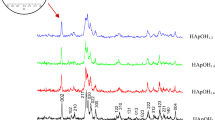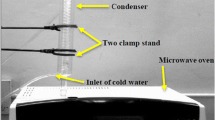Abstract
Bismuth and strontium ions were successfully substituted into hydroxyapatite (HAP) lattice upon the chemical formula \( {\text{Bi}}_{x} {\text{Sr}}_{y} {\text{Ca}}_{10 - x - y} ({\text{PO}}_{4} )_{6} \left( {\text{OH}} \right)_{2} \) via co-precipitation microwave-assisted route. The samples with different concentrations were investigated via X-ray diffraction, Fourier transform infrared, field emission scanning electron microscopy, thermogravimetric analysis and microhardness. In addition, lattice parameters, lattice distortion and crystallite size upon different models were computed. The two ions competed to replace both Ca2+ sites, and it was found that Bi3+ preferred Ca(2), while Sr2+ selected Ca(1). The hardness was enhanced via substitution where the highest value reached 3.1 GPa at the highest concentration of Bi3+ ions. This study has displayed that co-substituted ions into HAP can cause a great influence on its physico-chemical properties. The thorough study of the co-substitution effects is needed to deepen the understanding of synthetic HAP which may contribute in growth its applications particularly in bone tissue engineering.









Similar content being viewed by others
References
Mansour SF, El-dek SI, Dorozhkin SV, Ahmed MK (2017) Physico-mechanical properties of Mg and Ag doped hydroxyapatite/chitosan biocomposites. New J Chem 41:13773–13783
Mansour SF, El-Dek SI, Ahmed MK (2017) Physico-mechanical and morphological features of zirconia substituted hydroxyapatite nano crystals. Sci Rep 7:43202-1–43202-21
Popescu-Pelin G, Sima F, Sima LE, Mihailescu CN, Luculescu C, Iordache I et al (2017) Hydroxyapatite thin films grown by pulsed laser deposition and matrix assisted pulsed laser evaporation: comparative study. Appl Surf Sci 418:580–588
Lowry N, Brolly M, Han Y, McKillop S, Meenan BJ, Boyd AR (2018) Synthesis and characterisation of nanophase hydroxyapatite co-substituted with strontium and zinc. Ceram Int 44:7761–7770
Shanmugam S, Gopal B (2014) Antimicrobial and cytotoxicity evaluation of aliovalent substituted hydroxyapatite. Appl Surf Sci 303:277–281
de Leeuw NH (2010) Computer simulations of structures and properties of the biomaterial hydroxyapatite. J Mater Chem 20:5376–5389
Bulanov EN, Korshak KS, Lelet MI, Knyazev AV, Baikie T (2018) Bi-apatite: synthesis, crystal structure and low-temperature heat capacity. J Chem Thermodyn 124:74–78
Kazin PE, Pogosova MA, Trusov LA, Kolesnik IV, Magdysyuk OV, Dinnebier RE (2016) Crystal structure details of La- and Bi-substituted hydroxyapatites: evidence for LaO+ and BiO+ with a very short metal–oxygen bond. J Solid State Chem 237:349–357
Al-Hazmi FE (2016) Synthesis and electrical properties of Bi doped hydroxyapatite ceramics. J Alloy Compd 665:119–123
Sumathi S, Gopal B (2015) In vitro degradation of multisubstituted hydroxyapatite and fluorapatite in the physiological condition. J Cryst Growth 422:36–43
Pogosova MA, Provotorov DI, Eliseev AA, Jansen M, Kazin PE (2015) Synthesis and characterization of the Bi-for-Ca substituted copper-based apatite pigments. Dyes Pigments 113:96–101
Boyd AR, Rutledge L, Randolph LD, Meenan BJ (2015) Strontium-substituted hydroxyapatite coatings deposited via a co-deposition sputter technique. Mater Sci Eng C Mater Biol Appl 46:290–300
Kaygili O, Keser S, Kom M, Eroksuz Y, Dorozhkin SV, Ates T et al (2015) Strontium substituted hydroxyapatites: synthesis and determination of their structural properties, in vitro and in vivo performance. Mater Sci Eng C Mater Biol Appl 55:538–546
Bootchanont A, Sailuam W, Sutikulsombat S, Temprom L, Chanlek N, Kidkhunthod P et al (2017) Synchrotron X-ray absorption spectroscopy study of local structure in strontium-doped hydroxyapatite. Ceram Int 43:11023–11027
Bigi A, Falini G, Gazzano M, Roveri N, Tedesco E (1998) Structural refinements of strontium substituted hydroxylapatites. Mater Sci Forum 278–281:814–819
O’Donnell MD, Fredholm Y, de Rouffignac A, Hill RG (2008) Structural analysis of a series of strontium-substituted apatites. Acta Biomater 4:1455–1464
Curran DJ, Fleming TJ, Towler MR, Hampshire S (2011) Mechanical parameters of strontium doped hydroxyapatite sintered using microwave and conventional methods. J Mech Behav Biomed Mater 4:2063–2073
Zawisza K, Wiglusz RJ (2017) Preferential site occupancy of Eu3+ ions in strontium hydroxyapatite nanocrystalline—Sr10(PO4)6(OH)2—structural and spectroscopic characterisation. Dalton Trans 46:3265–3275
Zhang Y-G, Zhu Y-J, Chen F (2017) Novel interconnected nanochannel hydroxyapatite ceramics: synthesis, microstructure, and permeability. Ceram Int 43:5403–5411
Zaharia A, Muşat V, Anghel EM, Atkinson I, Mocioiu O-C, Buşilă M et al (2017) Biomimetic chitosan-hydroxyapatite hybrid biocoatings for enamel remineralization. Ceram Int 43:11390–11402
Venkateswarlu K, Chandra Bose A, Rameshbabu N (2010) X-ray peak broadening studies of nanocrystalline hydroxyapatite by Williamson–Hall analysis. Phys B 405:4256–4261
Matsunaga K, Kuwabara A (2007) First-principles study of vacancy formation in hydroxyapatite. Physical Review B 75:014102-1–014102-9
Mansour SF, El-dek SI, Ahmed MA, Abd-Elwahab SM, Ahmed MK (2016) Effect of preparation conditions on the nanostructure of hydroxyapatite and brushite phases. Appl Nanosci 6:991–1000
Prabhu YT, Rao KV, Kumar VSS, Kumari BS (2014) X-ray analysis by Williamson–Hall and size-strain plot methods of ZnO nanoparticles with fuel variation. World J Nano Sci Eng 04:21–28
Zhang J-M, Zhang Y, Xu K-W, Ji V (2006) General compliance transformation relation and applications for anisotropic hexagonal metals. Solid State Commun 139:87–91
Hing KA, Best SM, Bonfield W (1999) Characterization of porous hydroxyapatite. J Mater Sci Mater Med 10:135–145
Coats AW, Redfern JP (1964) Kinetic parameters from thermogravimetric data. Nature 201:68–69
Pérez-Maqueda LA, Sánchez-Jiménez PE, Criado JM (2005) Evaluation of the integral methods for the kinetic study of thermally stimulated processes in polymer science. Polymer 46:2950–2954
Faust JJ, Christenson W, Doudrick K, Ros R, Ugarova TP (2017) Development of fusogenic glass surfaces that impart spatiotemporal control over macrophage fusion: direct visualization of multinucleated giant cell formation. Biomaterials 128:160–171
Zhang J-M, Zhang Y, Xu K-W, Ji V (2007) Anisotropic elasticity in hexagonal crystals. Thin Solid Films 515:7020–7024
Kohlhauser C, Hellmich C (2012) Determination of Poisson’s ratios in isotropic, transversely isotropic, and orthotropic materials by means of combined ultrasonic-mechanical testing of normal stiffnesses: application to metals and wood. Eur J Mech A Solids 33:82–98
Shuai C, Feng P, Zhang L, Gao C, Hu H, Peng S et al (2013) Correlation between properties and microstructure of laser sintered porous β-tricalcium phosphate bone scaffolds. Sci Technol Adv Mater 14:055002-1–055002-10
Mg Holthaus, Twardy S, Stolle J, Riemer O, Treccani L, Brinksmeier E et al (2012) Micromachining of ceramic surfaces: hydroxyapatite and zirconia. J Mater Process Technol 212:614–624
Kiehlbauch JA, Hannett GE, Salfinger M, Archinal W, Monserrat C, Carlyn C (2000) Use of the national committee for clinical laboratory standards guidelines for disk diffusion susceptibility testing in New York state laboratories. J Clin Microbiol 38:3341–3348
Jorgensen JH, Swenson JM, Tenover FC, Ferraro MJ, Hindler JA, Murray PR (1994) Development of interpretive criteria and quality control limits for broth microdilution and disk diffusion antimicrobial susceptibility testing of Streptococcus pneumoniae. J Clin Microbiol 32:2448–2459
Zuo G, Wei X, Sun H, Liu S, Zong P, Zeng X et al (2017) Morphology controlled synthesis of nano-hydroxyapatite using polyethylene glycol as a template. J Alloy Compd 692:693–697
Moreira MP, de Almeida Soares GD, Dentzer J, Anselme K, de Sena LA, Kuznetsov A et al (2016) Synthesis of magnesium- and manganese-doped hydroxyapatite structures assisted by the simultaneous incorporation of strontium. Mater Sci Eng C Mater Biol Appl 61:736–743
Zheng X, Hui J, Li H, Zhu C, Hua X, Ma H et al (2017) Fabrication of novel biodegradable porous bone scaffolds based on amphiphilic hydroxyapatite nanorods. Mater Sci Eng C Mater Biol Appl 75:699–705
Ahmed MA, Mansour SF, El-dek SI, Abd-Elwahab SM, Ahmed MK (2014) Characterization and annealing performance of calcium phosphate nanoparticles synthesized by co-precipitation method. Ceram Int 40:12807–12820
Zhang N, Zhai D, Chen L, Zou Z, Lin K, Chang J (2014) Hydrothermal synthesis and characterization of Si and Sr co-substituted hydroxyapatite nanowires using strontium containing calcium silicate as precursors. Mater Sci Eng C Mater Biol Appl 37:286–291
Zhong S, Chen J, Li Q, Wang Z, Shi X, Lin K et al (2017) Assembly synthesis of spherical hydroxyapatite with hierarchical structure. Mater Lett 194:1–4
Author information
Authors and Affiliations
Corresponding authors
Rights and permissions
About this article
Cite this article
Ahmed, M.K., Mansour, S.F., Mostafa, M.S. et al. Structural, mechanical and thermal features of Bi and Sr co-substituted hydroxyapatite. J Mater Sci 54, 1977–1991 (2019). https://doi.org/10.1007/s10853-018-2999-4
Received:
Accepted:
Published:
Issue Date:
DOI: https://doi.org/10.1007/s10853-018-2999-4




